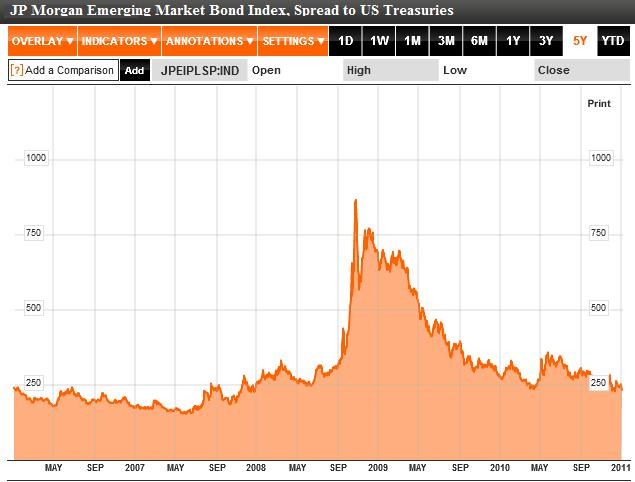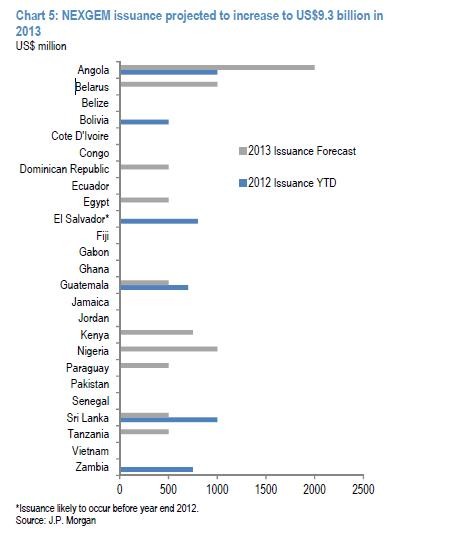Default risk rises for emerging and frontier markets
Post on: 21 Апрель, 2015 No Comment

Euromoney Country Risk data show emerging and frontier bonds had across-the-board increases in risk in 2014.
Probabilities of default compiled by using ECR survey data have risen for a large group of emerging and frontier sovereigns in response to reduced capital flows, falling commodity prices. tumbling currencies and political shocks.
The uncertainty has prompted economists and other risk experts to attach lower scores to an array of political, economic and structural risk factors.
Top of the list is Ukraine. Its default probability has risen by 12.5 points over 12 months, and at 147th in ECR’s survey, plummeting 22 places in ECR’s global rankings. is now considered, alongside Venezuela, one of the riskiest EMs worldwide, given its acute financing needs and low import cover.
Big risk of default
However, Ukraine is not alone. More than 25 of the highest-risk (junk-rated) credits in ECR’s tier-five category have become questionable for their investor safety.
Tier-five status does not guarantee a default, but it does indicate an extreme risk of doing so, notably among sovereigns within that category with falling score trends.
Countries with their budget spending financed by oil export revenue. and from inbound capital and migrant worker remittances from Russia, are a principal focus, with the rouble crisis now taking its toll on currency stability throughout the Commonwealth of Independent States (CIS) region.
Tier-four Kazakhstan, previously tipped for tier-three status recovering from its banking crisis, has fallen six places to 69th in ECR’s global rankings, while fellow tier-four sovereign Azerbaijan is four places lower in 78th place.
Belarus and the Kyrgyz Republic, falling respectively seven and three places lower in the survey to 152nd and 156th during Q4 2014, are even more embedded within tier five.
Lilit Gevorgyan. senior economist and country risk analyst at IHS Global Insight, believes that aside from Ukraine, Belarus is “the most vulnerable of the CIS regional sovereigns to the Russian crisis”.
Many CIS countries have seen remittances dwindle with the Russian economy in decline and unemployed migrant workers returning. Their depreciating currencies have brought additional political problems, by importing Russian inflation.
The authorities in Belarus, like others, have embarked on “damage-limitation control and are sending out reassuring messages”, Gevorgyan adds, “but with more than $4 billion-worth of debt repayments and servicing due in 2015, and its dependency on Russia factored in with concessional lending absent, default risk is higher for Belarus [as it is for Ukraine] than for other countries with stronger economies and reserves”.
Like Ukraine, Belarus has a one-in-five probability of default (PD) value attached – a high number considering that PDs only really escalate dramatically when real-time default is imminent.
These PDs derived from Citi’s model using ECR survey data are typically single-digit for most borrowers where the risks are considered bounded in the absence of shocks.
And like Ukraine, the risk has increased substantially for a range of countries, including Albania, Lebanon, Montenegro and Pakistan, as the table illustrates.
African woes
The highest defaulters group also contains a number of sub-Sahara African credits.
Among them are Mozambique, Tanzania, Liberia, Malawi, Uganda, Madagascar, Cameroon, Burkina Faso, the DRC, Sierra Leone and Guinea – all higher-risk portfolio options, which became even riskier in Q4 2014.
Tier-four Nigeria, Ghana, Angola and Algeria are similarly cascading down the rankings.
While these trends highlight the impact of the negative oil shock for large oil producers such as Angola, the slower pace of economic growth in China has also hurt demand for other resource-rich producers previously cashing in on the commodity boom.

The oil price shock affects Gabon too. Hydrocarbons revenue (oil and/or gas) provides 75% to 90% of fiscal revenue in these countries and there is undoubtedly a tougher year ahead, fiscally, until oil prices revive.
Political expedience means many are resisting quid-quo-pro currency adjustments, utilizing monetary tools to manage comparatively small depreciations.
“Some of these at-risk countries have accumulated fiscal savings,” says Samir Gadio. head of Africa strategy at Standard Chartered Bank.
“In that regard, Nigeria appears the most exposed, but it has low external debt and strong borrowing opportunities, both domestically and on the international markets,” which offers some protection, he adds.
Libya is an altogether different proposition. The price fall is merely compounding the difficulties of producing oil, given the political crisis and conflict. Like Russia and Ukraine, Libya has plummeted in ECR’s rankings – 44 places – taking the sovereign down from tier four to tier five.
Political risk
The unsettling presidential ouster in Burkina Faso, the failed coup in Gambia, and Islamist conflict in Cameroon and Nigeria destabilizing western Africa have all sent a stark reminder too of the dangers of political risk where the resource curse has for many countries failed to eradicate poverty, and non-concessional borrowing is on the rise.
Mongolia is down 23 places in the global rankings. Its problems were flagged by a falling ECR score trend. The government’s ability to maintain fiscal control and avoid a damaging payments crisis has been questioned by a debt ratio doubling since 2010 to around 65% of GDP, of which the external component has climbed above 50% of GDP, and is exacerbated by contractual wrangling in the mining sector.
Political risks are prevalent in Asia – Pakistan, for example – and Europe, too, as current developments in Greece highlight.
Several countries across eastern Europe are struggling to convince risk experts of their merits. They include Bulgaria, Albania and notably Bosnia-Herzegovina, where default risk has reached heightened levels.
This article was originally published by ECR. To find out more, register for a free trial at Euromoney Country Risk .
To receive similar stories, sign up for Regions and emerging markets emails.














